More flying wing experiences from Vaughn Entwistle
Wingfoot was a diminutive, 60 inch span plank. In configuration, it was based loosely on the "Little Plank" design of Dave Jones as featured in RCM. However, Wingfoot was constructionally completely different, with a unique fuselage and wing. The airfoil used was a hybrid E 182 morphed with a Quabeck airfoil that had originally been used on a German plank design featured in Sean Walbank’s White Sheet publication.
The basic parameters of Wingfoot were: 58 inch span, 12-1/2 inch constant chord, Aspect Ratio = 4.64. I can’t remember what the weight was, but it had two full sized servos, a 1200 mAH battery pack, and a full sized RX. Wingfoot featured full span strip elevons and used a sliding plywood servo tray for mixing. (I was a grad student at the time, so I couldn’t afford a fancy mixing radio.)
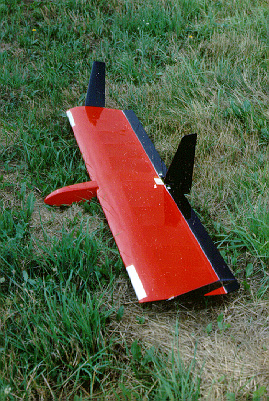 Despite its diminutive size, this was one of the most enjoyable sailplanes I’ve ever built. Performance was surprisingly good. With only 1/4" inch of dihedral at each wingtip, it was very stable, and announced the presence of thermals by violently kicking up a wing. The wing used built up construction with a 1/16" balsa sheeted D tube. The spar was 1/8" x 3/8" spruce with 1/64" shear webs glued to both side of the spar. This allowed Wingfoot to be launched off beefy high starts and even carefully winched.
Despite its diminutive size, this was one of the most enjoyable sailplanes I’ve ever built. Performance was surprisingly good. With only 1/4" inch of dihedral at each wingtip, it was very stable, and announced the presence of thermals by violently kicking up a wing. The wing used built up construction with a 1/16" balsa sheeted D tube. The spar was 1/8" x 3/8" spruce with 1/64" shear webs glued to both side of the spar. This allowed Wingfoot to be launched off beefy high starts and even carefully winched.
Performance was not F3B caliber, but compared to 60 inch handlaunches of the time (the middle ‘80s), it had a much better L/D and a vastly superior sink rate. Wingfoot was also extremely agile and could be tossed around the sky at will. Inside loops, outside loops, and snappy axial rolls were a blast to perform. Thermal performance was excellent, and getting down out of a thermal was usually accomplished by zipping across the sky to find some sink, or by pulling endless loops and rolls (no, it wouldn’t fly inverted).
I even experimented with adding winglets. These were very crude in design. They were simply some light balsa sheet that I sanded an airfoil into and attached to either tip with two-sided tape. Despite this, they were surprisingly effective. They increased the effective dihedral (not that it needed any more dihedral), and appeared to improve the sink rate. On the down side, the winglets slowed the roll rate (my axial rolls were not as snappy), and made the stall very violent. The winglets were obviously working, because Wingfoot would stall at a higher angle of attack than previously, and when it did finally stall, the stall was deeper and took longer to recover from.
From the first flight, however, one thing puzzled me about Wingfoot’s flight characteristics. I couldn’t seem to make the little plank perform a nice, flat thermal turn. Instead, it would instantly kick up at 45 degree angle. It still went up in a thermal just fine, but its turning characteristics puzzled me until one day I was checking the CG on a balance stand and happened to have the TX turned on. I then found to my surprise that as the elevons were moved up or down, the CG of the airplane moved (due to the sliding servo tray) pitching the nose up or down. Up elevon not only moved the elevons up, it also pushed the sliding servo tray backwards, pitching the nose up an additional amount, and vice-versa for down elevon. Now I understood the cause of the strange turning characteristics, I had inadvertently built-in a variable CG device!
To cure this problem I bought a Du-Bro mechanical mixer that provided mechanical mixing while allowing the servos to remain fixed in place. During the first high start launch with the Du Bro mixer attached, Wingfoot popped off the line at only sixty feet or so. I had a few seconds to fly her around and found that this had cured the problem. Wingfoot could now make nice flat, coordinated turns. I landed her at my feet and quickly relaunched, this time with the high start stretched all the way back. But with the faster launch, the air pressure on the elevons caused the Du-Bro mixer mechanism to slip and come loose(despite the fact that I’d tightened the Bejeezus out of the set screw). I knew instantly something had gone wrong as the elevons were fluttering uselessly and did not respond to my inputs. Wingfoot reached the top of the high start launch and arced over into a screaming vertical dive. Speed at impact was very impressive. The fuselage buried itself six inches in the soft ground and the entire airframe splintered into a thousand pieces.
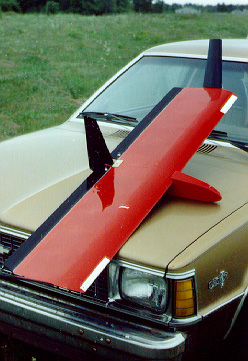 Despite the loss, the performance and flight characteristics of Wingfoot provided me with some valuable research information on plank performance that I plan to incorporate into a future design. One of the most interesting things about flying Wingfoot was its speed range. Most planks are one speed aircraft. However, because Wingfoot had span elevons, down elevator had the effect of reducing the reflex in the wing. At the same time as the elevon was going down, the sliding servo mechanism was moving the CG forward, also causing the nose to drop. But if down elevon was applied slowly and progressively, Wingfoot would accelerate and then seem to get up "on step," flying at a much higher speed, but flying straight and level--not diving.
This real-life observation would seem to support a theory advanced by the Kuhlmans in their "On the Wing" column in RCSD. Bill Kuhlman theorizes that, in the case of planks with full span elevons (like Wingfoot and The Birdworks’ "Zipper") as the speed increases, the positive pitching moment exerted by the reduced reflex is still sufficient to provide stability for the wing. Through our experiences with many different plank configurations, both Bill Kuhlman and I are also convinced that most of the airfoils traditionally used for plank wings have excessive reflex and are overly stable. (For some great essays on these and other topics, I highly recommend obtaining copies of "On the Wing" volumes 1 and 2 from the Kuhlmans. For information, check out their web site at
B2 Streamlines.
Despite the loss, the performance and flight characteristics of Wingfoot provided me with some valuable research information on plank performance that I plan to incorporate into a future design. One of the most interesting things about flying Wingfoot was its speed range. Most planks are one speed aircraft. However, because Wingfoot had span elevons, down elevator had the effect of reducing the reflex in the wing. At the same time as the elevon was going down, the sliding servo mechanism was moving the CG forward, also causing the nose to drop. But if down elevon was applied slowly and progressively, Wingfoot would accelerate and then seem to get up "on step," flying at a much higher speed, but flying straight and level--not diving.
This real-life observation would seem to support a theory advanced by the Kuhlmans in their "On the Wing" column in RCSD. Bill Kuhlman theorizes that, in the case of planks with full span elevons (like Wingfoot and The Birdworks’ "Zipper") as the speed increases, the positive pitching moment exerted by the reduced reflex is still sufficient to provide stability for the wing. Through our experiences with many different plank configurations, both Bill Kuhlman and I are also convinced that most of the airfoils traditionally used for plank wings have excessive reflex and are overly stable. (For some great essays on these and other topics, I highly recommend obtaining copies of "On the Wing" volumes 1 and 2 from the Kuhlmans. For information, check out their web site at
B2 Streamlines.
For those interested in building their own Wingfoot type plank, I would make the following recommendations:
1. Use a modern airfoil, such as the Phoenix, Selig 5010, EMX 07, AR 2411-S77, AR 2610-S80, or EH 2.0/10.0.
2. Keep the aspect ratio under 6. (The lower the AR, the more maneuverable.)
3. Use a fin mounted as far rearward as possible.
4. Use foam if possible, but keep it light.
5. Avoid mechanical mixing gadgets. Use servos in the wing with full span elevons.
WINGFOOT II
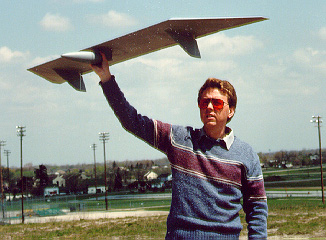 Wingfoot II was a joint endeavor with my friend, Keith Findling. Wingfoot II incorporated every "good idea" I’d had about improving over Wingfoot I. Unfortunately, as Keith and I found out, too many "good ideas" can lead to one very major "bad idea."
Wingfoot II was a joint endeavor with my friend, Keith Findling. Wingfoot II incorporated every "good idea" I’d had about improving over Wingfoot I. Unfortunately, as Keith and I found out, too many "good ideas" can lead to one very major "bad idea."
To improve efficiency we used the new Selig 5020 airfoil (good idea) and decided to use a sheeted foam core (good idea). Unfortunately, we chose 1/64" ply to sheet it with (bad idea). We also installed a spar heavy and strong enough for an F3B ship (bad idea). To get a good bond between the core and ply we used a lot of epoxy (bad idea). At the time, information was just starting to circulate about the Schueman planform and what are called "sheared tips." We both thought these sheared tips looked cool and decided to use them on the plank (very bad idea).
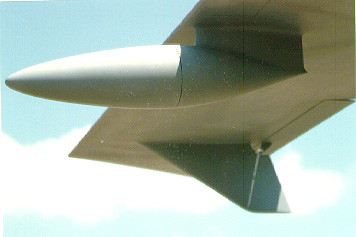 I’d always wanted to build a ship that had a low drag pod on a pylon for a fuselage (good idea). We then wondered how the thing would land and I had the brainstorm of using two fins on the underside of the wing that would double as fairings for the servo pushrods (good idea, but not in this case).
I’d always wanted to build a ship that had a low drag pod on a pylon for a fuselage (good idea). We then wondered how the thing would land and I had the brainstorm of using two fins on the underside of the wing that would double as fairings for the servo pushrods (good idea, but not in this case).
My friend Keith is an industrial designer and a master craftsman in just about every medium. Although he’d never worked with fiberglass previously, Keith made plugs for the fins and the pod out of basswood, then made molds from the plugs. The fit and finish of the pod and fins turned out of these molds was incredible, and professional mold makers who saw Keith’s molds and finished parts were blown away. Unfortunately, the fins were on the heavy side, and they probably weren’t far enough back from the aircraft’s AC to work properly, either.
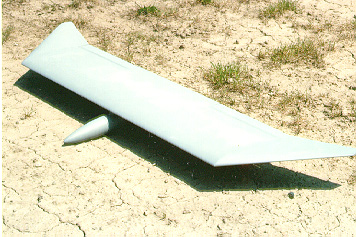 With all the pieces put together and painted in Stealth-gray primer, Wingfoot II looked extremely cool. Then we tried to figure out where the CG should be and balance it accordingly. By the time we got enough lead in the nose of the pod balance the thing, it had the heft and weight of a bowling ball. It was so comical, that Keith and I were actually falling about laughing. The first launch off the heavy duty high start was even more comical. Instead of climbing, Wingfoot II rocket straight forward at incredible speed. There followed a series of high speed, phugoid, whoop-de-do’s as it would dive at the ground, I’d correct, it would shoot upwards, I’d correct again, it would shoot downwards--but all at a mind-blurring speed. When Keith had stopped laughing, and my knees had stopped knocking together, we decided the high start wasn’t going to work and took Wingfoot II to a nearby slope. Here we bounced it off the bottom of the slope several times, breaking off a different part and regluing it on each time, until we managed to comprehensively destroy it all at once.
With all the pieces put together and painted in Stealth-gray primer, Wingfoot II looked extremely cool. Then we tried to figure out where the CG should be and balance it accordingly. By the time we got enough lead in the nose of the pod balance the thing, it had the heft and weight of a bowling ball. It was so comical, that Keith and I were actually falling about laughing. The first launch off the heavy duty high start was even more comical. Instead of climbing, Wingfoot II rocket straight forward at incredible speed. There followed a series of high speed, phugoid, whoop-de-do’s as it would dive at the ground, I’d correct, it would shoot upwards, I’d correct again, it would shoot downwards--but all at a mind-blurring speed. When Keith had stopped laughing, and my knees had stopped knocking together, we decided the high start wasn’t going to work and took Wingfoot II to a nearby slope. Here we bounced it off the bottom of the slope several times, breaking off a different part and regluing it on each time, until we managed to comprehensively destroy it all at once.
In the final analysis, Wingfoot II was a perfect example of how not to design an experimental flying machine. Instead of trying one new thing at a time, we tried everything new. And of course, it was all too heavy. How many aircraft have failed for that one reason?
As they say: Gravity sucks.
E-mail Andy MacDonald
BACK TO HOME PAGE
 Despite its diminutive size, this was one of the most enjoyable sailplanes I’ve ever built. Performance was surprisingly good. With only 1/4" inch of dihedral at each wingtip, it was very stable, and announced the presence of thermals by violently kicking up a wing. The wing used built up construction with a 1/16" balsa sheeted D tube. The spar was 1/8" x 3/8" spruce with 1/64" shear webs glued to both side of the spar. This allowed Wingfoot to be launched off beefy high starts and even carefully winched.
Despite its diminutive size, this was one of the most enjoyable sailplanes I’ve ever built. Performance was surprisingly good. With only 1/4" inch of dihedral at each wingtip, it was very stable, and announced the presence of thermals by violently kicking up a wing. The wing used built up construction with a 1/16" balsa sheeted D tube. The spar was 1/8" x 3/8" spruce with 1/64" shear webs glued to both side of the spar. This allowed Wingfoot to be launched off beefy high starts and even carefully winched.  Despite the loss, the performance and flight characteristics of Wingfoot provided me with some valuable research information on plank performance that I plan to incorporate into a future design. One of the most interesting things about flying Wingfoot was its speed range. Most planks are one speed aircraft. However, because Wingfoot had span elevons, down elevator had the effect of reducing the reflex in the wing. At the same time as the elevon was going down, the sliding servo mechanism was moving the CG forward, also causing the nose to drop. But if down elevon was applied slowly and progressively, Wingfoot would accelerate and then seem to get up "on step," flying at a much higher speed, but flying straight and level--not diving.
This real-life observation would seem to support a theory advanced by the Kuhlmans in their "On the Wing" column in RCSD. Bill Kuhlman theorizes that, in the case of planks with full span elevons (like Wingfoot and The Birdworks’ "Zipper") as the speed increases, the positive pitching moment exerted by the reduced reflex is still sufficient to provide stability for the wing. Through our experiences with many different plank configurations, both Bill Kuhlman and I are also convinced that most of the airfoils traditionally used for plank wings have excessive reflex and are overly stable. (For some great essays on these and other topics, I highly recommend obtaining copies of "On the Wing" volumes 1 and 2 from the Kuhlmans. For information, check out their web site at
Despite the loss, the performance and flight characteristics of Wingfoot provided me with some valuable research information on plank performance that I plan to incorporate into a future design. One of the most interesting things about flying Wingfoot was its speed range. Most planks are one speed aircraft. However, because Wingfoot had span elevons, down elevator had the effect of reducing the reflex in the wing. At the same time as the elevon was going down, the sliding servo mechanism was moving the CG forward, also causing the nose to drop. But if down elevon was applied slowly and progressively, Wingfoot would accelerate and then seem to get up "on step," flying at a much higher speed, but flying straight and level--not diving.
This real-life observation would seem to support a theory advanced by the Kuhlmans in their "On the Wing" column in RCSD. Bill Kuhlman theorizes that, in the case of planks with full span elevons (like Wingfoot and The Birdworks’ "Zipper") as the speed increases, the positive pitching moment exerted by the reduced reflex is still sufficient to provide stability for the wing. Through our experiences with many different plank configurations, both Bill Kuhlman and I are also convinced that most of the airfoils traditionally used for plank wings have excessive reflex and are overly stable. (For some great essays on these and other topics, I highly recommend obtaining copies of "On the Wing" volumes 1 and 2 from the Kuhlmans. For information, check out their web site at
 Wingfoot II was a joint endeavor with my friend, Keith Findling. Wingfoot II incorporated every "good idea" I’d had about improving over Wingfoot I. Unfortunately, as Keith and I found out, too many "good ideas" can lead to one very major "bad idea."
Wingfoot II was a joint endeavor with my friend, Keith Findling. Wingfoot II incorporated every "good idea" I’d had about improving over Wingfoot I. Unfortunately, as Keith and I found out, too many "good ideas" can lead to one very major "bad idea." I’d always wanted to build a ship that had a low drag pod on a pylon for a fuselage (good idea). We then wondered how the thing would land and I had the brainstorm of using two fins on the underside of the wing that would double as fairings for the servo pushrods (good idea, but not in this case).
I’d always wanted to build a ship that had a low drag pod on a pylon for a fuselage (good idea). We then wondered how the thing would land and I had the brainstorm of using two fins on the underside of the wing that would double as fairings for the servo pushrods (good idea, but not in this case).  With all the pieces put together and painted in Stealth-gray primer, Wingfoot II looked extremely cool. Then we tried to figure out where the CG should be and balance it accordingly. By the time we got enough lead in the nose of the pod balance the thing, it had the heft and weight of a bowling ball. It was so comical, that Keith and I were actually falling about laughing. The first launch off the heavy duty high start was even more comical. Instead of climbing, Wingfoot II rocket straight forward at incredible speed. There followed a series of high speed, phugoid, whoop-de-do’s as it would dive at the ground, I’d correct, it would shoot upwards, I’d correct again, it would shoot downwards--but all at a mind-blurring speed. When Keith had stopped laughing, and my knees had stopped knocking together, we decided the high start wasn’t going to work and took Wingfoot II to a nearby slope. Here we bounced it off the bottom of the slope several times, breaking off a different part and regluing it on each time, until we managed to comprehensively destroy it all at once.
With all the pieces put together and painted in Stealth-gray primer, Wingfoot II looked extremely cool. Then we tried to figure out where the CG should be and balance it accordingly. By the time we got enough lead in the nose of the pod balance the thing, it had the heft and weight of a bowling ball. It was so comical, that Keith and I were actually falling about laughing. The first launch off the heavy duty high start was even more comical. Instead of climbing, Wingfoot II rocket straight forward at incredible speed. There followed a series of high speed, phugoid, whoop-de-do’s as it would dive at the ground, I’d correct, it would shoot upwards, I’d correct again, it would shoot downwards--but all at a mind-blurring speed. When Keith had stopped laughing, and my knees had stopped knocking together, we decided the high start wasn’t going to work and took Wingfoot II to a nearby slope. Here we bounced it off the bottom of the slope several times, breaking off a different part and regluing it on each time, until we managed to comprehensively destroy it all at once.